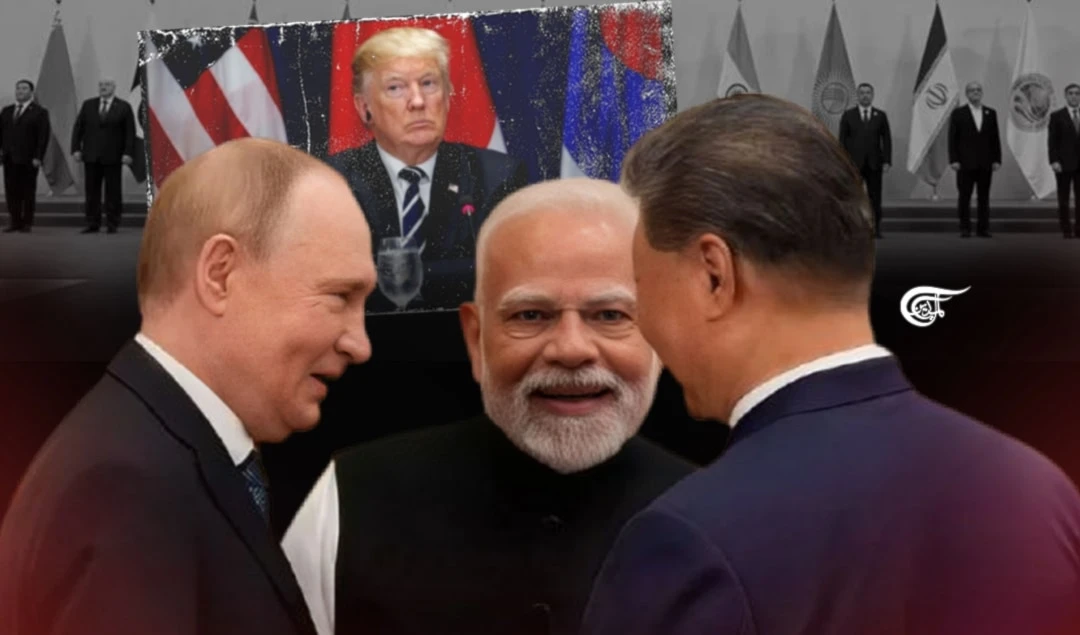Dedollarization: BRICS is getting ready to give the dollar a run for its money
China, the second-largest global economy, is rapidly reducing its ownership of US Treasury bonds while simultaneously boosting its gold reserves.
-

The BRICS 2024 summit will take place in Russia's Kazan region from October 22–24 (Illustrated by Mahdi Rteil to Al Mayadeen English)
The upcoming BRICS meeting in Russia will give top priority to the dedollarization agenda and take steps to further decrease the dependence on the US currency in cross-border trade between the nations. BRICS is currently exploring strategies to undermine the use of the dollar in worldwide corporate transactions.
In a recent interview, Sergey Ryabkov, the Deputy Foreign Minister of Russia, revealed that the dedollarization agenda would take center stage at the BRICS summit in 2024. The alliance will become stronger after the summit, ushering developing nations into a "whole new ball game," he said, adding that it will mark the summit's "big moment."
"The notion of a multi-polar world holds the key to dedollarization, where BRICS countries will break free from their dependence on the US dollar," he said. Ryabkov was hopeful that the BRICS would push the boat out and keep making strides "toward a better world."
"After completing a third of our presidency, the BRICS quickly established themselves as a formidable force in the global arena and a crucial participant in the constantly changing global landscape," he stated.
BRICS Summitt-2024
The BRICS 2024 summit will take place in Russia's Kazan region from October 22–24. The sixteenth summit will see the BRICS forum welcome Ethiopia, the United Arab Emirates (UAE), and Egypt as new members. Saudi Arabia may also participate in the upcoming summit, but only if the Kingdom approves. KSA has already received an invitation to join, but it has not yet announced whether it plans to join the cause. Saudi Arabia's entry into the bloc has the potential to boost the dedollarization drive.
Currently, a minimum of twenty countries, including Brazil and many Southeast Asian states, engage in bilateral trade using their currencies. Even Japan, a close US-EU ally, indicated that it would opt for the local currency for cross-border trade. The geopolitical divide and its economic ramifications have expedited the trend to shift away from the US dollar.
In February of last year, media sources claimed that the monthly transaction volume of the Chinese yuan in Russia exceeded the dollar for the first time.
Alongside the BRICS factor, the progressive depreciation of the US dollar as a medium of global trade operation is also attributable to the rapidly shifting financial and trade dynamics. Secondly, the US frequently violates its charter and slaps coercive and unilateral sanctions on nations refusing to come to terms with its expansionist designs.
The US's firm and obstinate stance on several global issues has resulted in the imposition of sanctions on its adversaries. Because of its currency exchange advantage, the US has frozen the assets of many nations, including Russia and Iran that disagree with its global policies. Russian and Iranian asset freezes have irritated the countries with US Treasury bonds, prompting them to withdraw their dollar holdings. Expressing dissent towards US foreign policy may result in asset seizure or suspension. It is necessary to have an alternative location to store those assets. According to reports, Saudi Arabia, a significant oil exporter in the Middle East, has indicated that it is willing to engage in trading using currencies other than the US dollar.
The US dollar's global reserves are decreasing
Over the past decade, the US dollar has accounted for over 70% of central banks' foreign exchange reserves, according to the IMF's Currency Composition of Foreign Exchange Reserves (COFER) projections. However, in the fourth quarter of 2022, its proportion declined to 58.36%.
China, the second-largest global economy, is rapidly reducing its ownership of US Treasury bonds while simultaneously boosting its gold reserves. According to figures issued by the US Treasury on Wednesday, Chinese ownership of US Treasury bonds decreased to $775 billion after seeing a decline of $22.7 billion in February and $18.6 billion in January. In February, China remained the second-largest holder of US government debt. However, China's holding of US government debt has been below the $1 trillion mark since April 2022.
With the onset of the global dedollarization trend, numerous countries have expedited the process of diversifying their reserves by augmenting their gold holdings and adopting local currencies for international transactions.
According to data released by the People's Bank of China, China's gold reserves rose to 2264.87 tons in the first quarter of 2024, up from 2235.39 tons in the fourth quarter of 2023. A country's central bank holds or controls its gold reserves.
China's foreign exchange reserves reached a record high of $3.246 trillion as of March 2024, making them the largest in the world. The Chinese economy experienced a significant increase of $19.8 billion in February 2024, surpassing market expectations. This growth will contribute to maintaining the overall stability of the country's foreign exchange reserves.
Interestingly, the US ally, Japan, is also dumping the dollar precisely because of the decline of the US economy and exchange rates, given the stunning internal and external debts. As of May 1, 2024, Japan had sold around $35 billion in US bonds against a $25 trillion US Treasury market. Last year, Japanese investors sold a record $30.8 billion in US shares, the largest since 1977.
As of January 2024, Japan held $1.15 trillion in US securities, making it the largest non-US Treasury securities holder. China is the second-largest foreign holder of US debt, with $775 billion in securities bonds as of April 21, 2024. The U.K. is the third-largest holder, with $700.8 billion in security bonds. The US debt-to-GDP ratio is now 134% and climbing, as US debts are increasing much faster than the GDP.
China's economy outperformed that of the US and its allies.
Chinese financial experts assert that while the nominal GDP growth rate in the US appears favorable, significant inflation is driving a portion of this growth, leading to the accumulation of risk factors throughout the US economy. They believe it is now a prevailing tendency to diversify the range of foreign assets.
As emerging economies, notably China, outpace the US and its Western allies, their share of world production has declined. China, the foremost economic competitor of the US, has become the principal commercial partner for more than 120 countries, with exports amounting to over £2.8 billion (US$3.6 trillion). This has the potential to cause the US to lag in the global race for trade dominance.
Over the past two decades, China's share of the global economy has grown by more than two-thirds, rising from 8.9% to 18.5%. In contrast, the United States has seen a decline in its share from 20.1% to 15.5% in terms of purchasing power parity, which measures the value of a currency by comparing the prices of specific products.
In 2021, the BRICS economies, which include Brazil, Russia, India, China, and South Africa, had a larger share of the global Gross Domestic Product (GDP) in terms of purchasing power parity compared to the G-7 developed economies of the United States, Canada, the United Kingdom, Germany, France, Italy, and Japan.
The US markets are now susceptible to significant financial disruptions due to US government debt expansion. As a result, several countries have opted for "de-dollarization" as a strategy to safeguard their economies. By February 2023, the budget deficit of the US government had grown to $723 billion, surpassing its receipts. The US's $31.46 trillion national debt is the result of a persistent budget deficit, which saw a fivefold increase compared to the preceding two decades. The current level of global debt stands at $235 trillion, signifying an exponential increase that is beyond sustainability.

 F.M. Shakil
F.M. Shakil
 8 Min Read
8 Min Read











